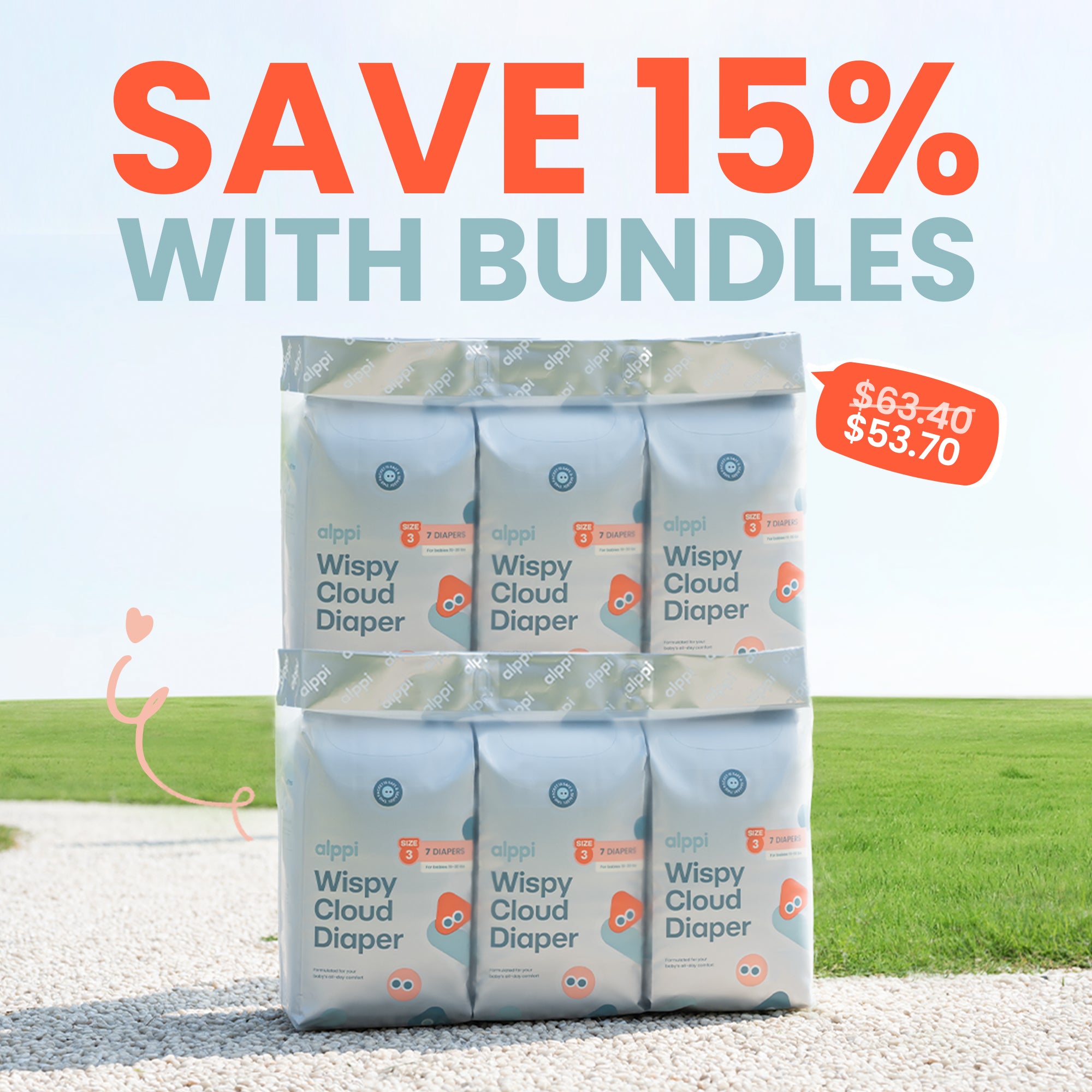So what are diapers made of? The answer goes far beyond “just paper and plastic.”
Diapers are made of several layers that combine materials like soft nonwoven fabrics, absorbent cellulose fluff pulp, and super-absorbent polymers to lock in moisture while keeping skin dry.
Both disposable and cloth diapers are built from different materials designed to absorb moisture and keep babies comfortable.
Disposable diapers usually contain cellulose fibers (wood pulp), super absorbent polymers, and thin layers of polypropylene and polyethylene, along with smaller parts like adhesives, tapes, and elastic bands.
Cloth diapers, in contrast, are often made from natural fabrics such as cotton, hemp, or bamboo. Some versions also include synthetic layers like microfiber or a waterproof polyurethane laminate (PUL) to boost performance.
Read on to understand the materials and layers, so you can see how each part plays a role in keeping your baby dry, healthy, and comfortable.
What Are Diapers Made Of?
Diapers combine layers of different materials to balance absorbency, comfort, and protection.
The type of diaper you choose—disposable or cloth—changes what those layers are made of and how they perform in daily use.
Quick Overview Of Disposable Vs. Cloth Diapers
Disposable diapers usually have three main parts:
- Top sheet (inner layer): Soft, nonwoven polypropylene touches your baby’s skin.
- Absorbent core: A mix of fluff pulp (from wood) and super absorbent polymer (SAP) that locks in liquid.
- Outer cover: Polyethylene film or a breathable fabric-like material that prevents leaks.
They also include elastics, adhesives, and fasteners to create a snug fit.
A single disposable diaper weighs around 1.4–1.8 ounces.
Cloth diapers, on the other hand, are usually made from cotton, bamboo, or microfiber fabrics. Some come with removable inserts for extra absorbency.
Instead of adhesives, cloth diapers use snaps, Velcro, or pins.
Why Materials Matter (Safety, Comfort, Eco, Cost)
The materials inside diapers affect your baby’s skin health, your budget, and even the environment.
Polypropylene and polyethylene in modern diapers are considered safe, but some parents prefer cloth to avoid plastics.
Cloth fabrics like cotton or bamboo feel softer but may not absorb as much as SAP-filled cores. Comfort also depends on fit and breathability.
Disposable diapers often use stretchy elastics and lightweight covers that keep moisture away from skin.
Cloth diapers can feel bulkier, but natural fibers allow more airflow.
From an eco perspective, disposables create more waste since they are single-use, while cloth diapers require water and energy for washing.
Cost is another factor: you’ll spend more upfront on cloth but save long-term, while disposables spread costs out but add up quickly.
Want to know the qualities that set the best diapers apart? Read our full guide: What Makes a Good Diaper?
Main Layers Of A Diaper
A diaper may look simple, but it’s built from several layers that each serve a clear purpose.
The inside manages moisture and keeps skin dry, while the outside prevents leaks and keeps everything in place.
Absorbent Core – Fluff Pulp + SAP
The absorbent core is where all the real work happens. This middle layer pulls in liquid, locks it away, and helps keep your baby’s skin dry.
It’s usually made of a mix of fluff pulp (derived from soft wood pulp) and super-absorbent polymer (SAP), most often sodium polyacrylate.
Fluff pulp creates a lightweight, cushiony structure that quickly wicks moisture from the topsheet.
SAP then swells into a gel-like form, holding many times its weight in liquid. This combination prevents wetness from pooling near the skin.
Some diapers also include an acquisition and distribution layer (ADL) above the core. This thin sheet spreads liquid evenly across the core so it absorbs faster and doesn’t clump in one spot.
Topsheet – Soft Layer Against Skin
The topsheet is the part that touches your baby’s skin directly. It needs to feel soft, breathable, and gentle, since it’s in constant contact with one of the most sensitive areas of the body.
Most topsheets are made from polypropylene nonwoven fabric. This material is designed to let liquid pass through quickly while staying dry to the touch.
Some brands add a lotion or aloe coating to reduce friction and help protect against irritation.
A good topsheet balances softness with function. If it holds onto liquid instead of transferring it into the core, skin stays damp and rash becomes more likely.
Backsheet – Leak-Proof Outer Cover
The backsheet is the thin, waterproof film you see on the outside of the diaper. Its main job is to stop liquid from escaping and soaking clothes, bedding, or your lap.
It’s often made from polyethylene film or a blend of polyethylene and polypropylene. Some backsheets are laminated with a soft nonwoven fabric to feel cloth-like instead of plastic. This helps the diaper stay discreet and more comfortable against the skin.
Modern backsheets are engineered to resist leaks while still letting some air flow. This breathability reduces heat and moisture buildup inside the diaper, which can help keep skin healthier over long wear times.
Elastics And Fasteners – Fit And Security
The final key parts are the elastics and fasteners. These make sure the diaper stays snug and moves with your baby without gaps.
Elastic threads are placed around the leg cuffs and waistband. They stretch and contract to create a seal that keeps liquid and mess inside.
Leg cuffs are especially important for containing runny stools, which can otherwise leak out quickly.
Fasteners, usually made of hook-and-loop tabs or adhesive strips, let you adjust the fit. They’re designed to be refastened multiple times without tearing the diaper.
Together with the elastic, they give you control over how secure and comfortable the diaper feels on your baby.
Carrying diapers should be simple and stylish. See why parents love our bag in Why Alppi's Diaper Bag Is Every Parent's Dream Come True!
Common Diaper Materials

Disposable diapers rely on a mix of absorbent, protective, and comfort-focused materials. Each layer has a specific role, from pulling in liquid to keeping skin dry and preventing leaks.
Cellulose Fluff And Super Absorbent Polymers
The absorbent core is where most of the work happens.
Cellulose fluff pulp, usually made from wood fibers, spreads liquid quickly across the diaper. This helps prevent pooling in one spot.
On top of that, diapers use super absorbent polymers (SAPs), often in the form of small gel beads. SAPs can hold many times their weight in liquid, locking moisture away from your baby’s skin. This combination of fluff and SAP balances speed and capacity.
Fluff pulp absorbs fast, while SAP stores liquid for hours. The result is dryness that helps protect against rashes and irritation.
Some brands reduce fluff and increase SAP to make diapers thinner. Others use more fluff to improve softness and comfort.
The exact mix depends on the brand’s design choices.
Polypropylene, Polyethylene, And Nonwovens
The outer and inner layers use polypropylene and polyethylene, two lightweight plastics. These materials are safe, durable, and commonly used in everyday products.
The topsheet, which touches the skin, is usually a non-woven fabric made of polypropylene. It feels soft, allows liquid through, and keeps the surface dry.
Nonwovens are breathable, giving airflow while still protecting against leaks. The backsheet, often made of polyethylene film or a laminated nonwoven, prevents liquid from escaping.
Some backsheets are designed with a cloth-like feel for added comfort. Elastic parts around the legs and waist also use polypropylene blends. These help the diaper fit snugly without cutting into the skin.
Together, these plastics and nonwovens create a balance of softness, breathability, and leak protection.
Adhesives, Lotions, And Additives
Diapers also need small but important extras. Adhesives hold the layers together and secure the tapes or fasteners. They’re usually applied in thin lines or dots, so you don’t even notice them.
Some diapers include lotions or skin conditioners on the topsheet. These may contain petroleum-based ointments, aloe, or vitamin E to reduce friction and soothe skin.
Not every diaper has them, so you can choose based on your baby’s needs.
Additives like dyes or pigments provide color, patterns, or wetness indicators that change when the diaper is full. While they don’t affect performance, they add convenience and style.
Fragrances are less common today, as many parents prefer fragrance-free options to avoid irritation. This makes modern diapers more skin-friendly while still being functional.
Eco-Friendly Diaper Materials

When you choose eco-friendly diapers, you’re looking for safer materials for your baby’s skin and products that reduce waste.
These diapers often replace plastics with natural fibers or plant-based layers and may even break down faster after use.
Bamboo, Cotton, And Plant-Based Options
Bamboo is one of the most common natural fibers in eco-friendly diapers. It’s soft, breathable, and naturally antibacterial, which helps keep your baby dry and comfortable.
Bamboo also grows quickly without needing pesticides, making it a sustainable choice.
Organic cotton is another popular option. Unlike conventional cotton, it’s grown without synthetic fertilizers or harsh chemicals.
This makes it gentle on sensitive skin and less harmful to the environment. Some brands even use cotton for the topsheet, the layer that touches your baby’s skin, instead of plastic-based fibers.
Plant-based materials, such as cornstarch or sugarcane, are often used to replace petroleum-based plastics in diaper backsheets and cores. These materials help reduce reliance on fossil fuels and make the diaper more biodegradable.
While not perfect, they’re a step toward lowering the environmental footprint of disposable diapers.
Key benefits of these materials:
- Softer feel against skin
- Reduced risk of irritation
- Lower chemical exposure
- More sustainable sourcing
Biodegradable And Compostable Alternatives
Some diapers go beyond plant-based fibers and are designed to break down more easily after use. Biodegradable diapers often use cornstarch films, wood pulp, or other natural fillers instead of plastics.
These materials decompose faster than conventional ones, though conditions like heat, moisture, and oxygen affect how quickly they break down.
Compostable diapers take this a step further. Certain brands make diapers with layers that can be composted in industrial facilities, and some even offer compostable packaging.
While home composting isn’t usually recommended for soiled diapers, these options still reduce landfill waste compared to standard disposables.
What you should look for:
- Chlorine-free processing to avoid harmful residues
- No phthalates, fragrances, or latex to protect sensitive skin
- Certified compostable packaging when available
Safety And Health Factors

When you choose diapers, you want to know they’re safe for your baby’s skin and free from unnecessary risks. The materials and ingredients used today reflect years of testing and changes in response to health concerns.
Chemicals Diapers No Longer Use
Modern disposable diapers have moved away from certain additives that once raised questions. For example, latex is no longer used in most brands because it could trigger allergic reactions.
Similarly, chlorine bleaching has been replaced by chlorine-free processes, which reduce the chance of creating harmful byproducts like dioxins.
Fragrances and dyes are also less common now. Many parents prefer fragrance-free options since added scents can irritate sensitive skin.
Some dyes, especially those in the waistband or leg cuffs, have been linked to mild rashes, so companies now limit or avoid them.
You’ll still see polymers like polypropylene and polyethylene, but these are considered inert and safe for skin contact. They help with absorbency and leak protection without being absorbed by the body.
Safety reviews by organizations such as the FDA and EU health agencies continue to monitor these materials to ensure they meet strict standards.
Skin Sensitivity And Rash Prevention
Your baby’s skin is thinner and more delicate than yours, which makes it more prone to irritation. Diaper rash often happens when moisture, friction, and bacteria build up against the skin.
Choosing diapers that wick away liquid quickly lowers this risk.
Some diapers include a thin layer of petrolatum or aloe in the liner. This acts as a protective barrier, helping to keep skin soft and reducing redness.
While petrolatum is widely used in baby ointments, you’ll want to make sure your child tolerates it well.
If your baby has sensitive skin, look for diapers labeled hypoallergenic and free from lotions, fragrances, and dyes. Frequent diaper changes, gentle wipes, and letting the skin air out for short periods also make a big difference in preventing rashes.
Ever wondered if diapers can expire? Find out in Decoding Diaper Expiration: Do Diapers Actually Expire?
Why Alppi Baby Diapers Are the Best Choice
When it comes to diapers, parents want safety, comfort, and performance. Alppi’s Wispy Cloud Diapers deliver all three. Made with totally chlorine-free, non-toxic materials, they’re gentle on delicate skin and help lower the risk of irritation or diaper rash.
Each diaper is built for performance, holding up to 42 fl oz of liquid to prevent leaks and keep your baby dry longer—meaning fewer changes and more restful sleep. The soft, breathable fabrics feel cloud-like against the skin, while the flexible waistband and secure closures ensure a snug fit, even for active babies.
Parents also love the eco-conscious design. By avoiding harmful chemicals and using safer, skin-friendly materials, Alppi makes diapers that are better for your baby and more responsible for the planet.

👉 Want to try them for yourself? Start with the Alppi Diaper Sample Pack—a simple way to test the comfort, absorbency, and fit before committing to a full box.
Final Thoughts
Choosing the right diaper starts with knowing what it’s made of. Alppi’s Wispy Cloud Diapers combine gentle, chlorine-free materials with cloud-soft comfort and powerful absorbency, giving your baby dryness and protection you can trust.
With their eco-conscious design and skin-friendly fabrics, they strike the perfect balance between health, comfort, and sustainability. Whether you’re looking for fewer leaks, better sleep, or safer materials, Alppi makes it easier to feel confident in your choice.
Next, check out our guide: How Often Should You Change Your Baby’s Diaper? A Simple Guide & Tips to keep your little one happy and rash-free.
Also, discover softness, safety, and performance in every diaper with our Alppi Wispy Cloud Diaper collection.
Frequently Asked Questions
What materials are typically used in disposable diapers?
Most disposable diapers have three main layers. The top sheet, which touches your baby’s skin, is usually made of soft polypropylene or plant-based fibers.
The absorbent core combines fluff pulp and super absorbent polymers (SAP) to lock in liquid, while the back sheet uses polyethylene or other breathable films to prevent leaks.
Elastic, adhesives, and fastening tabs hold everything in place. Some brands add lotion or aloe to the top sheet for skin comfort.
What is the main ingredient in diapers?
The most important material is the super absorbent polymer (SAP). This powdery substance can soak up many times its weight in liquid, keeping your baby’s skin dry.
Without SAP, disposable diapers wouldn’t be nearly as effective at preventing leaks or reducing rashes.
What did humans do before diapers?
Before modern diapers, parents used cloth squares, animal skins, or even moss as absorbent padding. In some cultures, babies went without diapers and caregivers practiced “elimination communication,” responding quickly when a child needed to go.
Disposable diapers only became common in the mid-20th century.
Are all diapers non-toxic?
Not all diapers are completely free from chemicals. Some may contain dyes, fragrances, or chlorine-bleached pulp.
However, many brands now offer hypoallergenic or chlorine-free options to reduce irritation and avoid unnecessary additives. Always check the label if you want to avoid specific materials.
Are diapers made out of corn?
Some eco-friendly diapers use corn-based materials like polylactic acid (PLA) for parts of the top sheet or back sheet. These plant-based plastics replace petroleum-based ones but don’t make the entire diaper biodegradable.
You’ll still find SAP and other synthetic components in most designs.
Why are there chemicals in diapers?
Chemicals are often added to improve performance. For example, adhesives keep the layers together.
Dyes mark the size or wetness indicators. Some lotions or fragrances are included for skin comfort or odor control.
While these ingredients are generally tested for safety, you can choose chemical-free brands if you prefer a simpler option.











